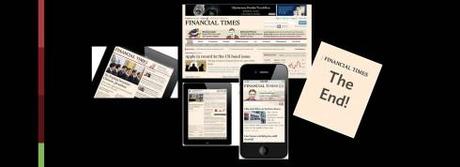TAKEAWAY: The Financial Times is on to something with its digital offerings that range from the dynamic to the static, recognizing that users want constant updates, but also that curated edition with a clear ending. PLUS: Estimating newspaper circulation gets tougher

As a media observer, I always keep an eye on whatever the Financial Times is doing, and not just because those guys in the peach-colored paper land that is the FT provide us with a pretty complete daily report on business, not to mention a fun, lean back Weekend edition, but, because they have a keen eye and ear for what their readers and users want. And they apply it.
Take, for example, the FT’s latest changes in its digital offerings. Of course, it continues to offer round the clock updated news through its digital platforms, but what is more interesting to us is the editors’ recognition of two things that I adhere to myself:
-A large portion of the digital audience hop from one platform to the other throughout the day, smartphones, computers, tablets. During the weekend, that may include sitting with good old printed newspaper editions.
Indeed, the FT’s tablet and mobile traffic is “pretty much on a par” with desktop usage at the weekend.
-People want their time with these digital platforms, whichever it is, to have a beginning, a middle and an end. The bottomless barrel that is an online edition is NOT what we want all day long, not with our smartphones and tablets, for sure. I equate it to a workout in the gym: you are happy to know that it will come to an end, and there is that satisfaction when it does. A feeling of fulfillment.
Tracking these reader habits informed the web app’s redesign, particularly the decision to offer static and dynamic versions to be switched between at will.
This from FT.com managing director Rob Grimshaw
“From the very early days, we’ve noticed that people like this sense of a finite read. Completion is a big thing for people, and in common with most publishers, we’re not great at giving people a sense of completion with our desktop experience.“
This means that we will see more of the FT combination of static and curated/finite smartphone and tablet editions. And, in fact, in several of the projects that we are currently engaged with, this is what we are recommending and creating.
It is not just about lean forward and lean back, it is also, and very importantly so, “happy to start, happy to finish”.
For more information:
Financial Times: ‘There is no drawback to working in HTML5’
http://www.guardian.co.uk/media/appsblog/2013/apr/29/financial-times-html5-no-drawbacks
The Economist goes after college students
It is a complicated world, we know that. It can be even more complicated for those young college kids going to class, worried about student loans, and making sure they major in careers with good job prospects.
Now The Economist, that sort of indispensable tool for anyone who wants to keep informed (regardless of age or station in life) is spending $1 million to spread out the word: Dare 2 Go Deep with The Economist.
The Economist also knows that these digital natives may only be interested in the digital editions of the magazine that calls itself a newspaper.
Read more here:
http://www.nytimes.com/2013/04/30/business/media/the-economist-looks-to-colleges-for-a-new-generation-of-readers.html?ref=media&_r=0
Daily newspaper circulation: who and what counts?
These two pieces deal directly with this important issue about newspaper readership (and measuring it), in the days of news consumption via the media quartet.
Daily newspaper circulation totals ‘do not capture the full story’ anymore
http://www.poynter.org/latest-news/top-stories/211067/newspaper-circulation-totals-do-not-capture-the-full-story-anymore/
Highlight:
Even at the great majority of papers still publishing print every day, Thursday and Friday totals are likely to be far higher than Monday and Tuesday since weekend subscriptions have become a standard offering.
When it comes to who’s reading newspapers, whose count counts?
Highlight:
Industry banking on digital readers, but it can’t agree how to measure their numbers.
http://www.sltrib.com/sltrib/money/56161451-79/analytics-web-adobe-com.html.csp
Fun with responsive design
Don’t miss this!
Responsive design in print
http://magculture.com/blog/?p=17209
Here’s a nice take on responsive design from the students of Helsinki University of Technology, created in response to Finnish newspaper Helsingin Sanomat’s change of format from broadsheet to tabloid.

